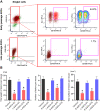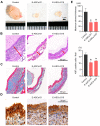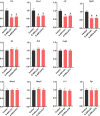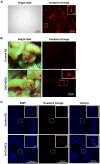Trophic and immunomodulatory effects of adipose tissue derived stem cells in a preclinical murine model of endometriosis
- PMID: 35577867
- PMCID: PMC9110373
- DOI: 10.1038/s41598-022-11891-5
Trophic and immunomodulatory effects of adipose tissue derived stem cells in a preclinical murine model of endometriosis
Abstract
Endometriosis, which exhibits enigmatic pathological features such as stromal fibrosis and proliferation of ectopic epithelial cells, is known as a refractory disease. Mesenchymal stem cells modulate the fibrosis in stromal tissues through their trophic and immunomodulatory properties. To investigate the potential of stem cells in treating endometriosis, we examined the secondary morphology and molecular alterations in endometriosis-like lesions after the administration of adipose tissue-derived stem cells (ASCs) to an experimental murine model of endometriosis. The infused ASCs were found integrated in the endometriosis-like lesions. Accompanied by the suppression of stromal fibrosis and proliferation of endometriotic epithelial cells, the infusion of ASCs with stemness potential (early passage of ASCs) suppressed the growth of endometriosis-like lesions and inhibited the expression of pro-inflammatory and pro-fibrotic cytokines, whereas no significant attenuation of endometriosis-like lesions occurred after the infusion of ASCs without stemness potential (late passage of ASCs). Accordingly, the trophic and immunomodulatory properties of ASCs may regulate fibrosis in endometriosis-like lesions, suggesting that regenerative medicine could be recognized as an innovative treatment for patients with endometriosis through the accumulation of evidence of preclinical efficacy.
© 2022. The Author(s).
Conflict of interest statement
The authors declare no competing interests.
Figures




Similar articles
-
Adipose-derived stromal/stem cells successfully attenuate the fibrosis of scleroderma mouse models.Int J Rheum Dis. 2020 Feb;23(2):216-225. doi: 10.1111/1756-185X.13764. Epub 2019 Dec 5. Int J Rheum Dis. 2020. PMID: 31808305
-
Cancer-associated mutations in endometriosis: shedding light on the pathogenesis and pathophysiology.Hum Reprod Update. 2020 Apr 15;26(3):423-449. doi: 10.1093/humupd/dmz047. Hum Reprod Update. 2020. PMID: 32154564 Review.
-
Therapeutic Potential of Adipose Stem Cells.Adv Exp Med Biol. 2021;1341:15-25. doi: 10.1007/5584_2018_248. Adv Exp Med Biol. 2021. PMID: 30051318 Review.
-
Adipose-derived stem cells: Sources, potency, and implications for regenerative therapies.Biomed Pharmacother. 2019 Jun;114:108765. doi: 10.1016/j.biopha.2019.108765. Epub 2019 Mar 25. Biomed Pharmacother. 2019. PMID: 30921703 Review.
-
Adipose stromal vascular fraction attenuates TH1 cell-mediated pathology in a model of multiple sclerosis.J Neuroinflammation. 2018 Mar 13;15(1):77. doi: 10.1186/s12974-018-1099-3. J Neuroinflammation. 2018. PMID: 29534751 Free PMC article.
Cited by
-
The role of fibrosis in endometriosis: a systematic review.Hum Reprod Update. 2024 Dec 1;30(6):706-750. doi: 10.1093/humupd/dmae023. Hum Reprod Update. 2024. PMID: 39067455 Free PMC article.
-
Transwell Culture with Adipose Tissue-Derived Stem Cells and Fertilized Eggs Mimics the In Vivo Development of Fertilized Eggs to Blastocysts in the Fallopian Tube: An Animal Study.Antioxidants (Basel). 2024 Jun 8;13(6):704. doi: 10.3390/antiox13060704. Antioxidants (Basel). 2024. PMID: 38929143 Free PMC article.
-
Interferon Signaling in the Endometrium and in Endometriosis.Biomolecules. 2022 Oct 25;12(11):1554. doi: 10.3390/biom12111554. Biomolecules. 2022. PMID: 36358904 Free PMC article. Review.
-
Impact of administering umbilical cord-derived mesenchymal stem cells to cynomolgus monkeys with endometriosis.Reprod Med Biol. 2023 Sep 8;22(1):e12540. doi: 10.1002/rmb2.12540. eCollection 2023 Jan-Dec. Reprod Med Biol. 2023. PMID: 37693240 Free PMC article.
-
WERF Endometriosis Phenome and Biobanking Harmonisation Project for Experimental Models in Endometriosis Research (EPHect-EM-Homologous): homologous rodent models.Mol Hum Reprod. 2025 Jul 3;31(3):gaaf021. doi: 10.1093/molehr/gaaf021. Mol Hum Reprod. 2025. PMID: 40628400 Free PMC article.
References
-
- D'Hooghe TM. Endometriosis. In: Berek JS, Novak E, editors. Berek and Novak’s Gynecology. 15. Lippincott Williams and Wilkins; 2011. pp. 505–556.
Publication types
MeSH terms
LinkOut - more resources
Full Text Sources
Medical

